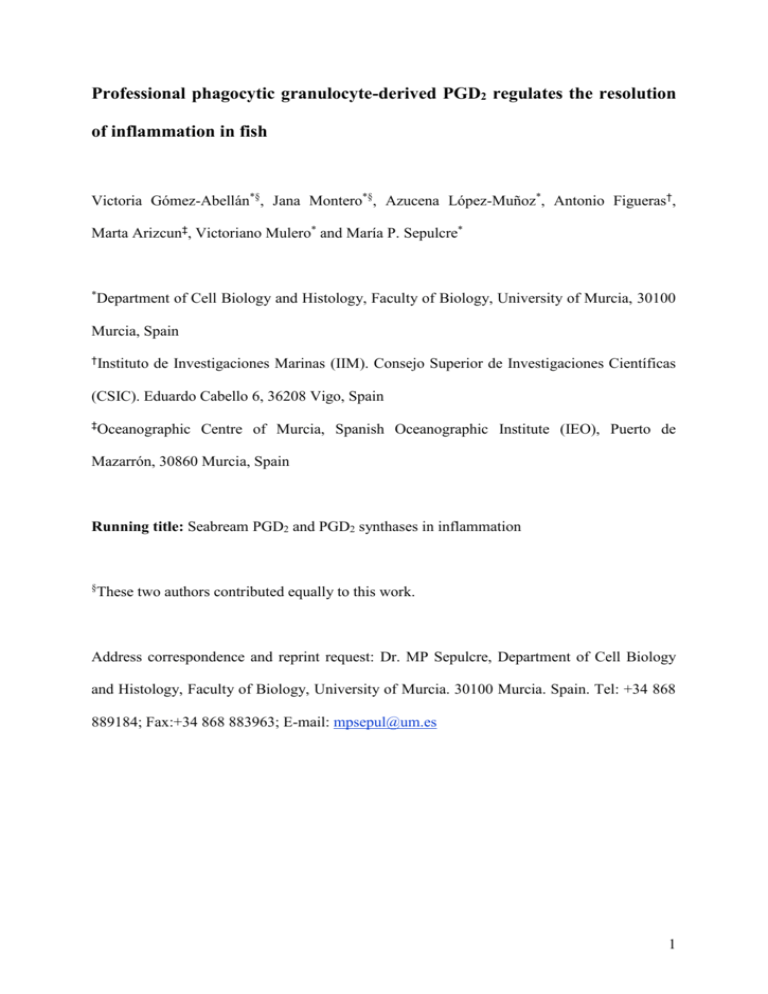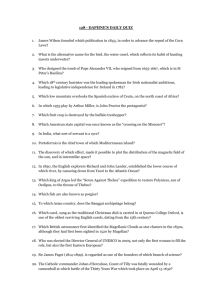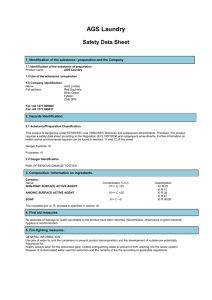INTRODUCCIÓN
advertisement

Professional phagocytic granulocyte-derived PGD2 regulates the resolution of inflammation in fish Victoria Gómez-Abellán*§, Jana Montero*§, Azucena López-Muñoz*, Antonio Figueras†, Marta Arizcun‡, Victoriano Mulero* and María P. Sepulcre* * Department of Cell Biology and Histology, Faculty of Biology, University of Murcia, 30100 Murcia, Spain †Instituto de Investigaciones Marinas (IIM). Consejo Superior de Investigaciones Científicas (CSIC). Eduardo Cabello 6, 36208 Vigo, Spain ‡Oceanographic Centre of Murcia, Spanish Oceanographic Institute (IEO), Puerto de Mazarrón, 30860 Murcia, Spain Running title: Seabream PGD2 and PGD2 synthases in inflammation § These two authors contributed equally to this work. Address correspondence and reprint request: Dr. MP Sepulcre, Department of Cell Biology and Histology, Faculty of Biology, University of Murcia. 30100 Murcia. Spain. Tel: +34 868 889184; Fax:+34 868 883963; E-mail: mpsepul@um.es 1 Abstract Prostaglandins (PGs) play a key role in the development on the immune response, through the regulation of both pro- and anti-inflammatory processes. PGD2 can be either proor anti-inflammatory depending on the inflammatory milieu. Prostaglandin D synthethase (PGDS) is the enzyme responsible for the conversion of PGH2 to PGD2. In mammals, two types of PGDS synthase have been described, the hematopoietic (H-PGDS) and the lipocalin (L-PGDS). In the present study we describe the existence of two orthologues of the mammalian L-PGDS (PGDS1 and PGDS2) in the gilthead seabream and characterize their gene expression profiles and biological activity. The results showed a dramatic induction of the gene coding for PGDS1 in acidophilic granulocytes (AGs), which are functionally equivalent to mammalian neutrophils, after a prolonged in vitro activation with different pathogen associated molecular patterns (PAMPs). In contrast PGDS2 was not expressed in these cells. The functional relevance of the induction of PGDS1 in AGs was confirmed by the ability of these cells to release PGD2 upon PAMP stimulation. To gain further insights into the role of PGD2 in the resolution of inflammation in fish, we examine the ability of PGD2 or its cyclopentenona derivates (cyPGs) to modulate the main functional activities of AGs. It was found that both PGD2 and cyPGs inhibited the production of reactive oxygen species and downregulated the transcript levels of the gene encoding interleukin-1β. Altogether, these results demonstrate that the use of PGD2 and its metabolites in the resolution of inflammation was established before the divergence of fish from tetrapods more than 450 million years ago and support a critical role for granulocytes in the resolution of inflammation in vertebrates. Free Keywords: prostaglandins, neutrophils, acidophilic granulocytes, seabream, teleosts. 2 Introduction Eicosanoids, including prostaglandins (PGs), leukotrienes (LTs) and lipoxins (LXs) are small fatty acid molecules derived from polyunsaturated fatty acids released from the cell membrane phospholipids, mainly araquidonic acid. Prostaglandins play a significant role in the progress of the immune response at multiple levels, often in concert with microbial ligands, cytokines, chemokines, and various other factors (Hirata and Narumiya, 2012). The first enzyme involved in PG biosynthesis is the cyclooxygenase (COX) which converts araquidonic acid to PGH2. There are several forms of COX: the COX-1 is constitutively expressed in nearly all cell types, while COX-2 is mainly inducible in inflammatory conditions and only expressed by a more limited range of cell types (Simmons et al., 2004). PGH2 is subjected to further conversion to give rise to the PG generation including PGE2 and PGD2. (Joo and Sadikot, 2012). PGD2 is converted to cyPGs, i.e. 15deoxy-12,14 PGJ2 and 12PGJ2, by albumin-independent and dependent reactions, respectively (Shibata et al., 2002). PGD2 synthase is the responsible for the production of PGD2 (the major prostaglandin in the central nervous system and in immune cells) from PGH2. In the most evolutionary organisms, two distinct types of PGD2 synthases have been identified: the hematopoietic form (H-PGDS) and the lipophilic ligand-carrier protein (lipocalin)-type enzyme (L-PGDS). These two enzymes share no homology in DNA and polypeptide sequences (Kanaoka et al., 1997) and show different tissue expression profiles, being L-PGDS mainly expressed in the CNS and related organs (Urade and Hayaishi, 2000) and H-PGDS in hematopoietic cells, including macrophages (Urade and Eguchi, 2002). Previous studies have reported an important role for H-PGDS in the control of the onset and resolution of acute inflammation (Rajakariar et al., 2007). However, while H-PGDS is constitutively expressed in macrophages, the L-PGDS is not detected in macrophages in normal conditions but expressed in a pathological 3 environment (Cipollone et al., 2004). The production of PGD2 by neutrophils has been controversial. Pouliot and coworkers reported that the main PGH2–derived metabolites produce in vitro by human neutrophil following activation with several inflammatory stimuli were TXB2 and PGE2, whereas they did not observed a detectable level of PGD2 (Pouliot et al., 1998). However, two more recent studies have shown the production of PGD2 by human neutrophils during spontaneous apoposis (Brown et al., 2003) and by mouse neutrophils during acute lung injury (Murata et al., 2013). Strikingly, H-PGDS was responsible for the production of PGD2 by mouse neutrophils (Murata et al., 2013). Taking into account that fish express several isoforms of L-PGDS, but none for HPGDS, the aim of this study was to determine the role of PGDSs and their products, PGD2 and cyPGDs, in the resolution of inflammation in the teleost fish gilthead seabream (Sparus aurata L.) and, in particular the contribution of acidophilic granulocytes (AGs), which are functionally equivalent to mammalian neutrophils (Cabas et al., 2013; Chaves-Pozo et al., 2005; Chaves-Pozo et al., 2004; Sepulcre et al., 2007; Sepulcre et al., 2011; Sepulcre et al., 2002), to the production of PGD2. 4 Materials and Methods Animals Healthy specimens (150 g mean weight) of the hermaphroditic protandrous marine fish gilthead seabream (Sparus aurata, Actinoperygii, Sparidae) were bred and kept at the Oceanographic Centre of Murcia (Spain) in a 14 m3 running seawater tank (dissolved oxygen 6 ppm, flow rate 20% tank volume/hour) with natural temperature and photoperiod, and fed twice a day with a commercial pellet diet (Skretting, Burgos, Spain). Fish were fasted for 24 hours before sampling. The experiments performed comply with the Guidelines of the European Union Council (86/609/EU) and the Bioethical Committee of the University of Murcia (Spain) for the use of laboratory animals. Isolation of phagocytes AGs were obtained by MACS as described earlier (Roca et al., 2006). Briefly, head kidney cell suspensions were incubated with a 1:10 dilution of a mAb specific to gilthead seabream AGs (G7) (Sepulcre et al., 2002), washed twice with PBS containing 2 mM EDTA (Sigma-Aldrich) and 5% FCS (Invitrogen) and then incubated with 100-200 l per 108 cells micro-magnetic-bead-conjugated anti-mouse IgG antibody (Miltenyi Biotec). After washing, G7+ (AGs) cell fractions were collected by MACS following the manufacturer’s instructions and their purity analyzed by flow cytometry (Roca et al., 2006). Cell culture and treatments Isolated AGs were stimulated at 23°C with 50 μg/ml phenol-extracted genomic DNA from Vibrio anguillarum ATCC19264 cells (VaDNA) or 100 ng/ml flagellin (Invivogen) in sRPMI [RPMI-1640 culture medium (Gibco) adjusted to gilthead seabream serum osmolarity (353.33 mOs) with 0.35% NaCl] supplemented with 0.1% FCS and 100 I.U./ml penicillin and 5 100 μg/ml strepomycin (Biochrom). These concentrations of PAMPs have been found to be optimal for in vitro activation of seabream AGs (Sepulcre et al., 2007). AGs were cultured with or without the synthetic stable analog of PGD2 (5-20 M, 16,16-dimethyl PGD2), the synthetic stable analog of 13,14-dihydro-15-keto PGD2 (5-20 M, 11-deoxy-11-methylene15-keto PGD2), 15-deoxy-12,14 PGJ2 (0.5-1 M) and 12PGJ2 (1-10 M) (Cayman Chemical). In vivo sampling and experimental infections Fish were injected intraperitoneally with 1ml of phosphate-buffered saline (PBS) alone or containing a sublethal dose (108) of exponentially growing V. anguillarum R82 cells (Chaves-Pozo et al., 2004). Head kidney, spleen, thymus, liver, gills, blood and peritoneal exudates cells were obtained 4 h after bacterial challenge. Gut and brain were obtained from PBS treated fishes. All samples were processed for subsequent real-time RT-PCR (see below). Analysis of gene expression Total RNA was extracted as indicated above and treated with DNase I, Amplification grade (1 unit/µg RNA, Life technologies). The SuperScrip III RNase H- ReverseTranscripase (Life technologies) was used to synthesize first strand cDNA with oligo-dT18 primer from 1 µg of total RNA at 50 ºC for 50 min. Real-time PCR was performed with an ABI PRISM 7500 instrument (Applied Biosystems) using SYBR Green PCR Core Reagents (Applied Biosystems). Reaction mixtures were incubated for 10 min at 95ºC, followed by 40 cycles of 15 s at 95ºC, 1 min at 60ºC, and finally 15 s at 95ºC, 1 min 60ºC and 15 s at 95ºC. For each mRNA, gene expression was corrected by the by the ribosomal protein S18 (rps18) content in 6 each sample using the comparative Ct method (2-ΔΔCt). The primers used are shown in Table 1. In all cases, each PCR was performed with triplicate samples and repeated at least twice. Measurement of PGD2 by EIA Evaluation of PGD2 was synthesis were performed by analyzing supernatants from AGs stimulated or not with VaDNA for one to 3 days using a commercial enzyme immunoassay (EIA) kit (Cayman Chemical). Cell viability Aliquots of cell suspensions were diluted in 200 l PBS containing 40 g/ml propidium iodide (PI). The number of red fluorescent cells (dead cells) from triplicate samples was analyzed by using flow cytometry. Respiratory burst assays Respiratory burst activity was measured as the luminol-dependent chemiluminescence produced by AGs after different times of stimulation (Mulero et al., 2001). This was brought by adding 100 M luminol and 1 g/ml PMA (both from Sigma-Aldrich), while the chemiluminescence was recorded every 117 seconds for 1 h in a FLUOstart luminometer (BGM, LabTechnologies). The values reported are the average of quadruple readings, expressed as the slope of the reaction curve from 117 to 1170 seconds, from which the apparatus background was subtracted. Statistical analysis Data were analyzed by ANOVA and a Tukey’s multiple range test to determine differences between groups. 7 RESULTS Identification of genes encoding PGDS in gilthead seabream Searches within publicly available EST database of the European Nucleotide Archive (ENA) allowed us to identify two genes encoding for gilthead seabream PGDS1 and PGDS2 (ENA accession numbers AM971774 and AM959591, respectively) (Fig. S1). An interesting difference between them was the presence of two ATTTA motifs in the 3’ untranslated region (UTR) of the PGDS1. These motifs have been shown to be responsible for the unstability of mammalian (Han et al., 1990) and fish (Roca et al., 2007) cytokine mRNAs. Both cDNAs encoded a single open reading frame which translated into putative 184 and 180 amino acid polypeptides, which showed 42.8% (PGDS1) and 46.1% (PGDS2) amino acid similarity to human L-PGDS. Alignment of the amino acid sequences deduced for both seabream PGDSs with non-mammalian homologous protein sequences deposited in the NCBI databases showed significant homologies to the lipocalin protein family (Figure 1). Previous studies showed that non-mammalian (zebrafish, xenopus and chicken) and mammalian L-PGDS formed an “LPGDS sub-family” in the lipocalin gene family (Fujimori et al., 2006). One of the features of this family is the presence of conserved folding patterns and three structurally conserved regions (SCRs) (Flower, 1993). Strikingly, however, zebrafish, rainbow trout and seabream L-PGDS all lacked in their primary structure the essential cysteine residue required for PGDS activity found in mammalian L-PGDS (Bayne et al., 2001; Fujimori et al., 2006; Urade et al., 1995). PGDS1 gene expression is induced upon AG activation As the production of PGD2 by mammalian neutrophils is controversial (Brown et al., 2003; Joo et al., 2007; Pouliot et al., 1998) , we analyzed the expression of PGDS1 and PGDS2 by RT-qPCR in seabream AGs, which are functionally equivalent to mammalian 8 neutrophils (Cabas et al., 2013; Chaves-Pozo et al., 2005; Chaves-Pozo et al., 2004; Sepulcre et al., 2007; Sepulcre et al., 2011; Sepulcre et al., 2002), following stimulation in vitro with different PAMPs. The results showed that VaDNA or flagellin stimulation resulted in a gradual increase of the mRNA levels of PGDS1 along the time of stimulation (Fig. 2a). Notably, PGDS2 was not expressed in control or stimulated AGs (data not shown). It is important to note that the expression of the genes encoding prostaglandin-endoperoxide synthase 2 (PTGS2 or COX2), the limiting enzyme in PGs production (Fig. 2b), and interleukin-1 (IL-1) (Fig. 2c) also showed a dramatic up-regulation but with different kinetics; peaking at the shortest time analyzed (1 day post-stimulation). AGs produce PGD2 following stimulation with PAMPs The expression data obtained in AGs, together with the fact that previous reports have shown that non-mammalian L-PGDSs have no, or very weak, PGDS activity (Fujimori et al., 2006) prompted us to analyze the production of PGD2 by these cells. The results showed that AGs were able to produce PGD2 in vitro and this production was significantly increased in response to stimulation with VaDNA (Fig.3). PGD2 and its derivates inhibit AG functions We next sought to determine the activity of PGD2 in the main AG functions, i.e. the production of reactive oxygen species (ROS) and cytokines. We used 16,16–dimethyl-PGD2, a metabolically stable synthetic analogue of PGD2 that signals through DP1 receptor (Gervais et al., 2001), and the chemically stable ligand of 13,14-dihydro-15-keto-PGD2 of the PGD2 metabolite 11-deoxy-11-methylene-15-keto-PGD2, which signals via the chemokine-related CRTH2 receptor (Hirai et al., 2001). It was found that physiological concentrations of both compounds inhibited in a dose-dependent manner the induction of ROS upon VaDNA 9 stimulation (Figs. 4a and 4b). However, cell viability was unaffected (data not shown). It is important to note that the effects of 11-deoxy-11-methylene-15-keto-PGD2 on ROS production was weaker than that of 16,16–dimethyl-PGD2. Similarly, only 16,16–dimethylPGD2 was able to inhibit the induced mRNA levels of IL-1 in response to VaDNA (Fig. 4c). In the view of these results, we also analyzed the effect of the cyPGs, 15-deoxy-12,14PGJ2 and 12PGJ2, in AGs activities. Similar to PGD2, both cyPGs decreased ROS production in a dose-dependent manner (Figs. 5a and 5b) and downregulated IL-1β expression by AGs (Fig. 5c). It is important to note that cyPGs exert their effects at lower doses and were more potent in comparison with PGD2. Collectively, all these results indicate that PGD2 and its derivates have a potent anti-inflammatory effect and suggest an important role of PGD2 released by seabream AGs in the resolution of inflammation. In vivo expression of seabream PGDSs and modulation upon bacterial infection The analysis of the constitutive expression of seabream PGDSs genes showed that both genes were expressed in all tissue examined, including key immune organs, like headkidney, spleen, thymus and gills, with the exception of PGDS2 in the gut (Figs. 6a and 6b). It is important to note that the highest mRNA levels of PGSD1 were found in liver, while those of PGDS2 were much higher in brain, gill and thymus. To determine whether seabream PGDS might be involved in bacterial infection, healthy seabream juveniles were challenged with the fish pathogenic bacterium V. anguillarum and then the expression of the gene encoding PTGS2, PGDS1 and PGDS2 were all analyzed. Notably, bacterial infection led to an increase in the mRNA levels of PTGS2 and PGSD1 in most of the tissues examined; being the blood the tissue where the increase was found to be the highest for the two genes (Figures 7a and 7b). In contrast, the mRNA levels of PGDS2 did not significantly changed (peritoneal exudates and liver), or even decreased 10 (head-kidney, thymus and gill), after the bacterial challenge, with the exception of the blood (Figure 7c). All these data further support a role for PGDS1 in the resolution of the inflammatory response in the gilthead seabream. Discussion PGDS is the enzyme responsible of the conversion of PGH2 to PGD2. Two types of PGDS synthase have been described, the hematopoietic (H-PGDS) and the lipocalin (LPGDS). This in silico work has revealed the existence of two L-PGDS orthologues in gilthead seabream (PGDS1 and PGDS2). In addition, H-PGDS orthologues have not been identified so far in the fish genomes available, including ancient, i.e. the zebrafish (Cypriniformes), and most evolutionary advance, i.e. pufferfish (Tetraodontiformes), teleost fish. All these data point to L-PGDS as the responsible of PGD2 synthesis in gilthead seabream. In addition, the results of the tissue distribution of both L-PGDS genes suggest different roles for these two molecules. In this context, in the view of that the highest levels of expression PGDS2 were found in the brain, together with its weak modulation after bacterial challenge, and taking into consideration that mammalian L-PGDS is mainly expressed in CNS and related organs (Taniike et al., 2002; Urade et al., 1993), seabream PGDS2 might be considered functionally equivalent to mammalian L-PGDS. A pro-inflammatory role of L-PGDS has been reported in models of allergic inflammation (Satoh et al., 2006) and other inflammation models (Hokari et al., 2011; Nagata et al., 2009; Ogawa et al., 2006; Uehara et al., 2009). Other studies have shown using gain and loss of function strategies in mice an important role for L-PGDS in the innate immune response (Joo et al., 2007; Joo and Sadikot, 2012). Here we have shown the induction of PGDS1 and PGDS2 expression in different tissues of seabream challenged with V. anguillarum, but with different patterns, being in both cases the blood the tissue where the 11 changes were more evident. The modulation of the expression of PGDS1 and PGDS2 by bacterial challenge was weaker in comparison with the changes observed in the mRNA levels of PTGS2, which is upstream in the prostanoid biosynthesis pathway. This means that other PGH2 derivates could be involved in the clearance of the bacteria and resolution of the infection. Collectively, these results suggest that mainly seabream PGDSs would contribute to host defense against bacterial infection. Previous studies have shown the contribution of L-PGDS in the production of PGD2 by macrophages stimulated with LPS or bacterial infection (Joo et al., 2007). However no reports exist about the contribution of L-PGDS in the production of PGD2 by neutrophils. Accumulating evidence suggests that seabream AGs could be considered the cell functional equivalent to mammalian neutrophils (Cabas et al., 2013; Chaves-Pozo et al., 2005; ChavesPozo et al., 2004; Sepulcre et al., 2007; Sepulcre et al., 2011; Sepulcre et al., 2002). We demonstrate herein that AGs do not express PGDS2 constitutively or after stimulation with PAMPs. However, VaDNA or flagellin stimulation induced PGDS1 expression in AGs in a time dependent manner. In contrast, the induction of the expression of PTGS2 in AGs occurs early after stimulation with VaDNA or flagellin. This data are consistent with the observations made by Joo et al. (2007) showing that macrophages stimulated with LPS express PTGS2 before L-PGDS expression by differentially using key transcription factors (NF-B and AP-1, respectively), ensuring that a sufficient amount of PGH2 is available for L-PGDS to produce PGD2 (Joo et al., 2007). In agreement with this, the expression of IL-1β, which is also modulated by NF-B, showed the same kinetics than PTGS2. L-PGDS is a bifunctional protein, acting as a PGD2 producing enzyme an also as an intercellular transporter of lipophilic molecules (Fujimori et al., 2006). Previous studies have shown that both zebrafish and chicken PGDSs lack enzymatic activity, while they are able to bind thyroxine and all-trans retinoic acid, like mammalian L-PGDSs and other lipocalin gene 12 family proteins (Fujimori et al., 2006). However, the role of this amino acid in the activity of fish L-PGDS homologues is not clear, since a zebrafish mutant L-PGDS with reconstituted cysteine (G59C) also lacks enzymatic activity (Fujimori et al., 2006). Given the induction of seabream PGDS1 expression in AGs stimulated with PAMPs, we wondered to determine the production of PGD2 by these cells and the contribution of PGDS1 in this process. Our results demonstrate that seabream AGs are able to produce PGD2 and this production is increased upon stimulation with VaDNA with a similar kinetics than PGDS1 expression. These results suggest that PGDS1 may be responsible for the production of PGD2 that, in turn, would be involved in the resolution of the inflammatory response in this species. Although further studies are needed for determine the role of seabream PGDS1 in this process, it is tempting to speculate that it could contribute to PGD2 production by AGs. Nowadays, very few reports exist regarding the role of PGD2 production by neutrophils and its role in the resolution of inflammation. Taken into account that gilthead seabream AGs are considered the functional equivalent to mammalian neutrophils, these results led us to hypothesize that the production of PGD2 by neutrophils could be an essential component in the resolution of the inflammation in vertebrates. The role of PGD2 in immune response is complex because it can elicit proinflammatory and anti-inflammatory effects depending on the inflammatory milieu. In addition PGD2 can exert its function by the interaction with two G protein-coupled receptors: the D prostanoid recepor 1 (DP1) and the chemoattractant receptor-homologous molecule expressed on Th2 cells (CRTH2)(Gervais et al., 2001) . CRTH2 has been shown to be expressed in various mouse immune cells, including Th1 cells, Th2 cells, eosinophils, monocytes, and neutrophils (Kim and Luster, 2007; Takeshita et al., 2004) In this study, we demonstrate that stable synthetic analogues of PGD2 (16,16–dimethyl-PGD2) and its derivate 11-deoxy-11-methylene-15-keto-PGD2, an specific agonist for CRTH2, at micromolar 13 concentrations, decrease the production of ROS by AGs stimulated in vitro with PAMPs. In addition, both of them were also able to down-regulate the mRNA levels of IL-1β in stimulated AGs. Therefore, these results show that PGD2 produced by stimulated AGs exerts an anti-inflammatory effect by their own. Nevertheless, PGD2 is a relative unstable molecule, which is readily degraded by a series of spontaneous dehydration and isomerization reactions into biologically active prostaglandins of the J2 series, namely PGJ2, 12PGJ2 and 15-deoxy12,14 PGJ2, called CyPGs. Therefore, the role of PGD2 in inflammation is complex because the net effect may depend on the rate of the production of its distal products. In this regards, we demonstrate herein that both CyPGs also exerts anti-inflammatory effects on AGs activities by decreasing ROS production and the expression of IL-1β. It is noteworthy that CyPGs were more potent and exert their effects at lower doses than PGD2. Thus, it is tempting to speculate that some of the regulatory effects of PGD2 in the late phases of the resolution of the inflammation may also arise from its induction of other families of PGH2 derivates. In summary, in this study we provide proof that PGD2, likely produced by PGDS1, plays an important role in the resolution of the inflammation in gilthead seabream. In addition, we demonstrate that AGs, the cells functionally equivalent to mammalian neutrophils, synthesize PGD2 that directly or via the production of its metabolites CyPGs regulates the resolution of the inflammatory response by controlling the balance of anti- vs. pro-inflammatory mediators as well as by decreasing ROS production. Furthermore our results suggest the importance of L-PGDS in the production PGD2 in lower vertebrates, which lacks H-PGDS. 14 Acknowledgements We thank Inma Fuentes and Pedro J. Martínez for excellent technical assistance, Drs. AE Toranzo and JL Barja (University of Santiago) for the R82 strain of V. anguillarum. Footnotes 1 This work was supported by the Spanish Ministerio de Economía y Competitividad (research grant AGL2012-39674 to M.P.S., PhD fellowship to V.G., and Juan de la Cierva contract to J.M., all co-funded with Fondos Europeos de Desarrollo Regional/European Regional Development Funds). 2 Abbreviations: acidophilic granulocytes, AGs; PAMPs, pathogen-associated molecular patterns; PG, prostaglandin; ROS, reactive oxygen species; VaDNA, genomic DNA from Vibrio anguillarum. 15 Figure legends Figure 1. Alignment of the amino acid sequences predicted from seabream PGDSs and the corresponding zebrafish L-PGDSb and human L-PGDS cDNAs. Amino acid sequences predicted from seabream L-PGDS cDNAs were compared with those of known zebrafish L-PGDSb and human L-PGDS cDNAs. The Cys residue essential for PGDS activity in mammals are emphasized by grey background, and the two Cys residues required for the disulfide-bond formation are indicated in bold. Three SCRs (Structural Conserved Regions) are indicated by closed squares inside the alignment. Figure 2. PGDS1 expression is induced upon AG activation. AGs were stimulated for 1, 3, 6 and 10 days with 50 g/ml VaDNA or 0.1g/ml flagellin in sRPMI supplemented with 5% FCS and the mRNA levels of pgds1 (A) and pgts2 (B) and il1b (C) were studied by realtime RT-PCR .The gene expression is normalized against rps18 and expressed as mean±S.E of the gene mRNA fold increase in stimulated cells relative to non cultured cells. Different letters denote statistically significant differences among the groups according to a Tukey test. The groups marked with “a” did not show statistically significant differences from control cells (p<0.05). Figure 3. PGD2 production by AGs upon stimulation. Head kidney AGs were stimulated for 1 and 3 days with 50 g/ml VaDNA in sRPMI supplemented with 5% FCS and the production of PGD2 was analyzed in the supernatants by ELISA. The data are expressed as mean±S.E (n=3). Different letters denote statistically significant differences among the groups according to a Tukey test. The groups marked with “a” did not show statistically significant 16 differences from one day cultured control cells The results are representative of two independent experiments. (p<0.05). Figure 4. Anti-inflammatory effect of PGD2 in AGs activities. Head kidney AGs were incubated for 16 h with the indicated concentrations of 16,16–dimethyl-PGD2 (a stable synthetic analog of PGD2) (A) or 11-deoxy-methylene-15-keto-PGD2 (a stable synthetic analog of 13,14-dihydro-15-keto-PGD2 ) (B), with or without 50 g/ml of VaDNA and their respiratory burst activity was measured. The results are representative of six independent experiments. The mRNA levels of the gene coding for IL-1 were determined by real-time RT-PCR (C). The gene expression is normalized against rps18 and is shown as relative to the mean of control cells incubated in medium alone. Different letters denote statistically significant differences among the groups according to a Tukey test. The groups marked with “a” did not show statistically significant differences from control cells. The results are representative of three independent experiments. (p<0.05). Figure 5. Anti-inflammatory effect of PGJ2 in AGs activities. Head kidney AGs were incubated for 16 h with the indicated concentrations of 15-deoxy-12,14 PGJ2 (A) or 12PGJ2 (B) with or without 50 g/ml of VaDNA and their respiratory burst activity was measured. The results are representative of six independent experiments. The mRNA levels of the gene coding for IL-1 were determined by real-time RT-PCR (C). The gene expression is normalized against rps18 and is shown as relative to the mean of control cells incubated in medium alone. The results are representative of two independent experiments. Different letters denote statistically significant differences among the groups according to a Tukey test. The groups marked with “a” did not show statistically significant differences from control cells (p<0.05). 17 Figure 6. Ubiquitous tissue expression pattern of seabream PGDSs. The mRNA levels of pgds1 (A) and pgds2 (B) were determined by real-time RT-PCR in the indicated tissues of control adult specimens. The results are expressed relative to ribosomal protein S18 and as the mean ± S.E.M. of triplicate Different letters denote statistically significant differences among the groups according to a Tukey test. Figure 7. Tissue expression pattern of seabream PG synthesis related genes following infection. The mRNA levels of pgds1 (A), pgds2 (B) and ptgs2 (C) were studied by real-time RT-PCR in the indicated immune of control specimens or following 4 h challenge with 108 cells of Vibrio anguillarum. The results are expressed as the gene mRNA fold increase in infected fish relative to control fish. The results are presented as mean ± S.E.M. from triplicate samples. Statistically significant differences from non-infected fish according to a Tukey test are shown as: n.s. (not significant), *p<0.05; **p<0.01; ***p<0.001. References: Bayne, C.J., Gerwick, L., Fujiki, K., Nakao, M., Yano, T., 2001. Immune-relevant (including acute phase) genes identified in the livers of rainbow trout, Oncorhynchus mykiss, by means of suppression subtractive hybridization. Developmental and comparative immunology 25, 205-217. Brown, J.R., Goldblatt, D., Buddle, J., Morton, L., Thrasher, A.J., 2003. Diminished production of anti-inflammatory mediators during neutrophil apoptosis and macrophage phagocytosis in chronic granulomatous disease (CGD). J Leukoc Biol 73, 591-599. Cabas, I., Rodenas, M.C., Abellan, E., Meseguer, J., Mulero, V., Garcia-Ayala, A., 2013. Estrogen Signaling through the G Protein-Coupled Estrogen Receptor Regulates Granulocyte Activation in Fish. J Immunol 191, 4628-4639. Cipollone, F., Fazia, M., Iezzi, A., Ciabattoni, G., Pini, B., Cuccurullo, C., Ucchino, S., Spigonardo, F., De Luca, M., Prontera, C., Chiarelli, F., Cuccurullo, F., Mezzetti, A., 2004. 18 Balance between PGD synthase and PGE synthase is a major determinant of atherosclerotic plaque instability in humans. Arteriosclerosis, thrombosis, and vascular biology 24, 12591265. Chaves-Pozo, E., Mulero, V., Meseguer, J., Garcia Ayala, A., 2005. Professional phagocytic granulocytes of the bony fish gilthead seabream display functional adaptation to testicular microenvironment. J Leukoc Biol 78, 345-351. Chaves-Pozo, E., Pelegrin, P., Garcia-Castillo, J., Garcia-Ayala, A., Mulero, V., Meseguer, J., 2004. Acidophilic granulocytes of the marine fish gilthead seabream (Sparus aurata L.) produce interleukin-1beta following infection with Vibrio anguillarum. Cell and tissue research 316, 189-195. Flower, D.R., 1993. Structural relationship of streptavidin to the calycin protein superfamily. FEBS Lett 333, 99-102. Fujimori, K., Inui, T., Uodome, N., Kadoyama, K., Aritake, K., Urade, Y., 2006. Zebrafish and chicken lipocalin-type prostaglandin D synthase homologues: Conservation of mammalian gene structure and binding ability for lipophilic molecules, and difference in expression profile and enzyme activity. Gene 375, 14-25. Gervais, F.G., Cruz, R.P., Chateauneuf, A., Gale, S., Sawyer, N., Nantel, F., Metters, K.M., O'Neill G, P., 2001. Selective modulation of chemokinesis, degranulation, and apoptosis in eosinophils through the PGD2 receptors CRTH2 and DP. J Allergy Clin Immunol 108, 982988. Han, J., Brown, T., Beutler, B., 1990. Endotoxin-responsive sequences control cachectin/tumor necrosis factor biosynthesis at the translational level. J Exp Med 171, 465475. Hirai, H., Tanaka, K., Yoshie, O., Ogawa, K., Kenmotsu, K., Takamori, Y., Ichimasa, M., Sugamura, K., Nakamura, M., Takano, S., Nagata, K., 2001. Prostaglandin D2 selectively induces chemotaxis in T helper type 2 cells, eosinophils, and basophils via seventransmembrane receptor CRTH2. J Exp Med 193, 255-261. Hirata, T., Narumiya, S., 2012. Prostanoids as regulators of innate and adaptive immunity. Advances in immunology 116, 143-174. Hokari, R., Kurihara, C., Nagata, N., Aritake, K., Okada, Y., Watanabe, C., Komoto, S., Nakamura, M., Kawaguchi, A., Nagao, S., Urade, Y., Miura, S., 2011. Increased expression of lipocalin-type-prostaglandin D synthase in ulcerative colitis and exacerbating role in murine colitis. American journal of physiology. Gastrointestinal and liver physiology 300, G401-408. Joo, M., Kwon, M., Sadikot, R.T., Kingsley, P.J., Marnett, L.J., Blackwell, T.S., Peebles, R.S., Jr., Urade, Y., Christman, J.W., 2007. Induction and function of lipocalin prostaglandin D synthase in host immunity. J Immunol 179, 2565-2575. Joo, M., Sadikot, R.T., 2012. PGD synthase and PGD2 in immune resposne. Mediators Inflamm 2012, 503128. Kanaoka, Y., Ago, H., Inagaki, E., Nanayama, T., Miyano, M., Kikuno, R., Fujii, Y., Eguchi, N., Toh, H., Urade, Y., Hayaishi, O., 1997. Cloning and crystal structure of hematopoietic prostaglandin D synthase. Cell 90, 1085-1095. Kim, N., Luster, A.D., 2007. Regulation of immune cells by eicosanoid receptors. ScientificWorldJournal 7, 1307-1328. Murata, T., Aritake, K., Tsubosaka, Y., Maruyama, T., Nakagawa, T., Hori, M., Hirai, H., Nakamura, M., Narumiya, S., Urade, Y., Ozaki, H., 2013. Anti-inflammatory role of PGD2 in acute lung inflammation and therapeutic application of its signal enhancement. Proc Natl Acad Sci U S A 110, 5205-5210. 19 Nagata, N., Fujimori, K., Okazaki, I., Oda, H., Eguchi, N., Uehara, Y., Urade, Y., 2009. De novo synthesis, uptake and proteolytic processing of lipocalin-type prostaglandin D synthase, beta-trace, in the kidneys. The FEBS journal 276, 7146-7158. Ogawa, M., Hirawa, N., Tsuchida, T., Eguchi, N., Kawabata, Y., Numabe, A., Negoro, H., Hakamada-Taguchi, R., Seiki, K., Umemura, S., Urade, Y., Uehara, Y., 2006. Urinary excretions of lipocalin-type prostaglandin D2 synthase predict the development of proteinuria and renal injury in OLETF rats. Nephrology, dialysis, transplantation : official publication of the European Dialysis and Transplant Association - European Renal Association 21, 924-934. Pouliot, M., Gilbert, C., Borgeat, P., Poubelle, P.E., Bourgoin, S., Creminon, C., Maclouf, J., McColl, S.R., Naccache, P.H., 1998. Expression and activity of prostaglandin endoperoxide synthase-2 in agonist-activated human neutrophils. FASEB J 12, 1109-1123. Rajakariar, R., Hilliard, M., Lawrence, T., Trivedi, S., Colville-Nash, P., Bellingan, G., Fitzgerald, D., Yaqoob, M.M., Gilroy, D.W., 2007. Hematopoietic prostaglandin D2 synthase controls the onset and resolution of acute inflammation through PGD2 and 15-deoxyDelta12 14 PGJ2. Proc Natl Acad Sci U S A 104, 20979-20984. Roca, F.J., Cayuela, M.L., Secombes, C.J., Meseguer, J., Mulero, V., 2007. Posttranscriptional regulation of cytokine genes in fish: A role for conserved AU-rich elements located in the 3'-untranslated region of their mRNAs. Molecular immunology 44, 472-478. Roca, F.J., Sepulcre, M.A., Lopez-Castejon, G., Meseguer, J., Mulero, V., 2006. The colonystimulating factor-1 receptor is a specific marker of macrophages from the bony fish gilthead seabream. Molecular immunology 43, 1418-1423. Satoh, T., Moroi, R., Aritake, K., Urade, Y., Kanai, Y., Sumi, K., Yokozeki, H., Hirai, H., Nagata, K., Hara, T., Utsuyama, M., Hirokawa, K., Sugamura, K., Nishioka, K., Nakamura, M., 2006. Prostaglandin D2 plays an essential role in chronic allergic inflammation of the skin via CRTH2 receptor. J Immunol 177, 2621-2629. Sepulcre, M.P., Lopez-Castejon, G., Meseguer, J., Mulero, V., 2007. The activation of gilthead seabream professional phagocytes by different PAMPs underlines the behavioural diversity of the main innate immune cells of bony fish. Molecular immunology 44, 20092016. Sepulcre, M.P., Lopez-Munoz, A., Angosto, D., Garcia-Alcazar, A., Meseguer, J., Mulero, V., 2011. TLR agonists extend the functional lifespan of professional phagocytic granulocytes in the bony fish gilthead seabream and direct precursor differentiation towards the production of granulocytes. Molecular immunology 48, 846-859. Sepulcre, M.P., Pelegrin, P., Mulero, V., Meseguer, J., 2002. Characterisation of gilthead seabream acidophilic granulocytes by a monoclonal antibody unequivocally points to their involvement in fish phagocytic response. Cell and tissue research 308, 97-102. Shibata, T., Kondo, M., Osawa, T., Shibata, N., Kobayashi, M., Uchida, K., 2002. 15-deoxydelta 12,14-prostaglandin J2. A prostaglandin D2 metabolite generated during inflammatory processes. J Biol Chem 277, 10459-10466. Simmons, D.L., Botting, R.M., Hla, T., 2004. Cyclooxygenase isozymes: the biology of prostaglandin synthesis and inhibition. Pharmacological reviews 56, 387-437. Takeshita, K., Yamasaki, T., Nagao, K., Sugimoto, H., Shichijo, M., Gantner, F., Bacon, K.B., 2004. CRTH2 is a prominent effector in contact hypersensitivity-induced neutrophil inflammation. Int Immunol 16, 947-959. Taniike, M., Mohri, I., Eguchi, N., Beuckmann, C.T., Suzuki, K., Urade, Y., 2002. Perineuronal oligodendrocytes protect against neuronal apoptosis through the production of lipocalin-type prostaglandin D synthase in a genetic demyelinating model. J Neurosci 22, 4885-4896. Uehara, Y., Makino, H., Seiki, K., Urade, Y., 2009. Urinary excretions of lipocalin-type prostaglandin D synthase predict renal injury in type-2 diabetes: a cross-sectional and 20 prospective multicentre study. Nephrology, dialysis, transplantation : official publication of the European Dialysis and Transplant Association - European Renal Association 24, 475-482. Urade, Y., Eguchi, N., 2002. Lipocalin-type and hematopoietic prostaglandin D synthases as a novel example of functional convergence. Prostaglandins & other lipid mediators 68-69, 375382. Urade, Y., Hayaishi, O., 2000. Prostaglandin D synthase: structure and function. Vitamins and hormones 58, 89-120. Urade, Y., Kitahama, K., Ohishi, H., Kaneko, T., Mizuno, N., Hayaishi, O., 1993. Dominant expression of mRNA for prostaglandin D synthase in leptomeninges, choroid plexus, and oligodendrocytes of the adult rat brain. Proc Natl Acad Sci U S A 90, 9070-9074. Urade, Y., Tanaka, T., Eguchi, N., Kikuchi, M., Kimura, H., Toh, H., Hayaishi, O., 1995. Structural and functional significance of cysteine residues of glutathione-independent prostaglandin D synthase. Identification of Cys65 as an essential thiol. J Biol Chem 270, 1422-1428. 21









